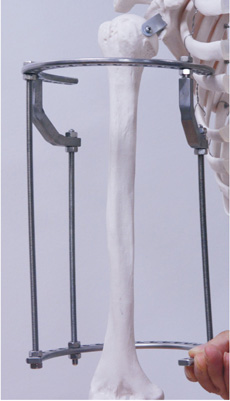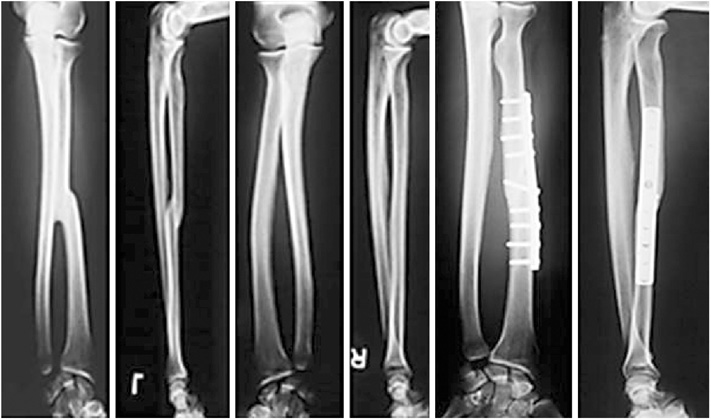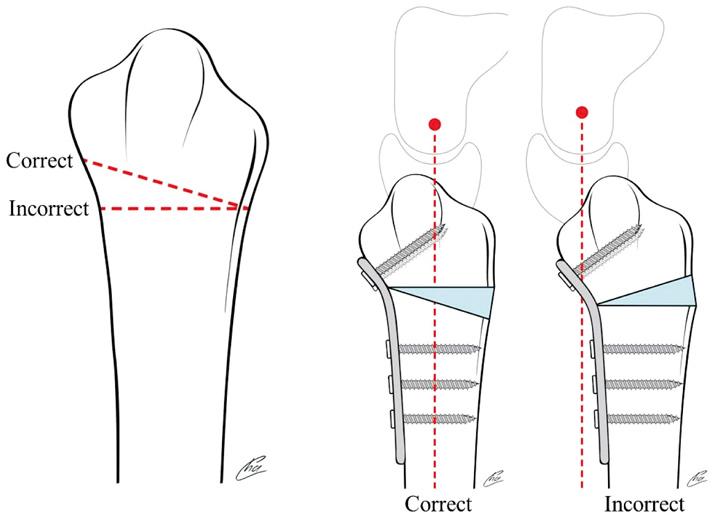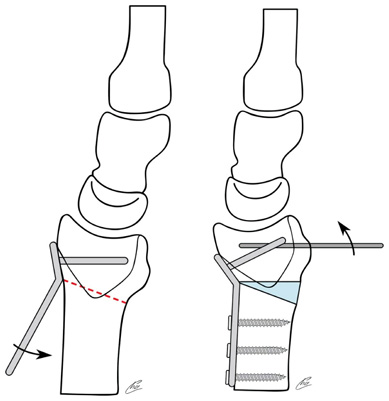J Korean Fract Soc.
2017 Oct;30(4):209-218. 10.12671/jkfs.2017.30.4.209.
Malunion: Deformity Correction of the Upper Extremity
- Affiliations
-
- 1Department of Orthopedic Surgery, Chungnam National University Hospital, Chungnam National University School of Medicine, Daejeon, Korea. hyunsd@cnu.ac.kr
- KMID: 2424134
- DOI: http://doi.org/10.12671/jkfs.2017.30.4.209
Abstract
- Malunions after fractures are classified as shortened, angulated, torsion, or rotational deformities that is outside the acceptable range, regardless of the location, whether upper or lower extremity. The distinct feature of a malunion in the upper extremity is that it is free from weight bearing; thus, some degree of shortening is allowed compared with the contralateral normal side in long bones, such as the humerus, radius, or ulna. However, malunions associated with functional impairment, especially angulated or rotational deformities, are more likely to develop instability, degenerative lesions, or rarely, compressive neuropathy. Hence, malunions with such association may occasionally require correction.
Keyword
Figure
Reference
-
1. Cattaneo R, Catagni MA, Guerreschi F. Applications of the Ilizarov method in the humerus. Lengthenings and nonunions. Hand Clin. 1993; 9:729–739.2. Cattaneo R, Villa A, Catagni MA, Bell D. Lengthening of the humerus using the Ilizarov technique. Description of the method and report of 43 cases. Clin Orthop Relat Res. 1990; (250):117–124.3. Paley D, Kelly D. Lengthening and deformity correction in the upper extremities. Atlas Hand Clin. 2000; 5:117–172.4. Davids JR, Lamoreaux DC, Brooker RC, Tanner SL, Westberry DE. Translation step-cut osteotomy for the treatment of post-traumatic cubitus varus. J Pediatr Orthop. 2011; 31:353–365.
Article5. Eamsobhana P, Kaewpornsawan K. Double dome osteotomy for the treatment of cubitus varus in children. Int Orthop. 2013; 37:641–646.
Article6. Solfelt DA, Hill BW, Anderson CP, Cole PA. Supracondylar osteotomy for the treatment of cubitus varus in children: a systematic review. Bone Joint J. 2014; 96-B:691–700.7. Cha SM, Shin HD, Ahn JS. Relationship of cubitus varus and ulnar varus deformity in supracondylar humeral fractures according to the age at injury. J Shoulder Elbow Surg. 2016; 25:289–296.
Article8. Oppenheim WL, Clader TJ, Smith C, Bayer M. Supracondylar humeral osteotomy for traumatic childhood cubitus varus deformity. Clin Orthop Relat Res. 1984; (188):34–39.
Article9. Bellemore MC, Barrett IR, Middleton RW, Scougall JS, Whiteway DW. Supracondylar osteotomy of the humerus for correction of cubitus varus. J Bone Joint Surg Br. 1984; 66:566–572.
Article10. Ahn SR, Shin HD, Rhee KJ, Lee JK, Jeong JT. Supracondylar quadrilateral displacement osteotomy for cubitus varus deformity: new operative technique. J Korean Orthop Assoc. 1998; 33:326–334.
Article11. Hui JH, Torode IP, Chatterjee A. Medial approach for corrective osteotomy of cubitus varus: a cosmetic incision. J Pediatr Orthop. 2004; 24:477–481.12. DeRosa GP, Graziano GP. A new osteotomy for cubitus varus. Clin Orthop Relat Res. 1988; (236):160–165.
Article13. Moradi A, Vahedi E, Ebrahimzadeh MH. Surgical technique: spike translation: a new modification in step-cut osteotomy for cubitus varus deformity. Clin Orthop Relat Res. 2013; 471:1564–1571.
Article14. Kumar K, Sharma VK, Sharma R, Maffulli N. Correction of cubitus varus by French or dome osteotomy: a comparative study. J Trauma. 2000; 49:717–721.
Article15. Banerjee S, Sabui KK, Mondal J, Raj SJ, Pal DK. Corrective dome osteotomy using the paratricipital (triceps-sparing) approach for cubitus varus deformity in children. J Pediatr Orthop. 2012; 32:385–393.
Article16. Bauer AS, Pham B, Lattanza LL. Surgical correction of cubitus varus. J Hand Surg Am. 2016; 41:447–452.
Article17. Takeyasu Y, Oka K, Miyake J, Kataoka T, Moritomo H, Murase T. Preoperative, computer simulation-based, three-dimensional corrective osteotomy for cubitus varus deformity with use of a custom-designed surgical device. J Bone Joint Surg Am. 2013; 95:e173.
Article18. Zhang YZ, Lu S, Chen B, Zhao JM, Liu R, Pei GX. Application of computer-aided design osteotomy template for treatment of cubitus varus deformity in teenagers: a pilot study. J Shoulder Elbow Surg. 2011; 20:51–56.
Article19. Takagi T, Takayama S, Nakamura T, Horiuchi Y, Toyama Y, Ikegami H. Supracondylar osteotomy of the humerus to correct cubitus varus: do both internal rotation and extension deformities need to be corrected? J Bone Joint Surg Am. 2010; 92:1619–1626.
Article20. Morrey BF, Askew LJ, Chao EY. A biomechanical study of normal functional elbow motion. J Bone Joint Surg Am. 1981; 63:872–877.
Article21. Müller ME, Allgöwer M, Willenegger H. Technique of internal fixation of fractures. New York: Springer-Verlag;1965.22. Dumont CE, Thalmann R, Macy JC. The effect of rotational malunion of the radius and the ulna on supination and pronation. J Bone Joint Surg Br. 2002; 84:1070–1074.
Article23. Sardelli M, Tashjian RZ, MacWilliams BA. Functional elbow range of motion for contemporary tasks. J Bone Joint Surg Am. 2011; 93:471–477.
Article24. Trousdale RT, Linscheid RL. Operative treatment of malunited fractures of the forearm. J Bone Joint Surg Am. 1995; 77:894–902.
Article25. Jayakumar P, Jupiter JB. Reconstruction of malunited diaphyseal fractures of the forearm. Hand (N Y). 2014; 9:265–273.
Article26. Jupiter JB, Fernandez DL, Levin LS, Wysocki RW. Reconstruction of posttraumatic disorders of the forearm. Instr Course Lect. 2010; 59:283–293.
Article27. Margaliot Z, Haase SC, Kotsis SV, Kim HM, Chung KC. A meta-analysis of outcomes of external fixation versus plate osteosynthesis for unstable distal radius fractures. J Hand Surg Am. 2005; 30:1185–1199.
Article28. Weckesser EC. Rotational osteotomy of the metacarpal for overlapping fingers. J Bone Joint Surg Am. 1965; 47:751–756.
Article29. Gross MS, Gelberman RH. Metacarpal rotational osteotomy. J Hand Surg Am. 1985; 10:105–108.
Article
- Full Text Links
- Actions
-
Cited
- CITED
-
- Close
- Share
- Similar articles
-
- A Correction of Malunion or Deformity in the Lower Extremity
- Lengthening & Deformity Correction in Upper Extremities by the Ilizarov Method
- Spontaneous Correction of the Angular Deformity after Femoral Shaft Fractures in Children: Preliminery Report
- Spontaneous Correction of Angular Deformity after femoral Shaft Fracture in children
- Clinical and Radiological Analysis of Angular Deformity of Lower Extremities











